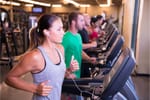If you think getting into the best shape of your life is complicated like rocket science, then you may be surprised to discover that you’ve been misled. The truth is, sculpting a great physique is typically a simple and straightforward process if you follow a few fundamental guidelines.
But it’s not your fault if you’ve believed all of the dieting nonsense that has plagued us all for decades.
Following false information leads you to make the wrong decisions, which leads to mistakes that can literally be physically harmful.
The good news is that it’s not too late to turn your situation around by arming yourself with better fitness knowledge.
And it starts right here, right now, since you’re about to discover the Top 20 Exercise Tips For Beginners.
Let’s get started…
Tip 1: Consult Your Doctor Prior to Starting an Exercise Program
Prior to getting involved with any kind of training or workout program, it is imperative that you visit a doctor first.
This way, he or she can get you checked out to determine if you are fit enough to handle certain types of workout routines.
Aside from that, he or she may also be able to tell you what exercises you need the most, in order to achieve your goals faster.
Tip 2: How to Avoid Injuries
In order to avoid injuries, you need to make sure that each exercise routine you perform is done properly.
To achieve that, you can ask an expert such as a personal trainer for help with the proper form.
This is important not just in preventing injuries, but also in making sure that you can achieve your goals faster by training the specific muscle each movement is intended to work.
Tip 3: Sleep at least 8 Hours Each Night
Each time you work out, you have to consider the fact that you are breaking down your muscles on a cellular level.
If you want to get your muscles to grow, then you have to provide your body with enough time to repair them.
When you sleep for at least 8 hours every night, not only would you be providing your body a chance to repair your muscles, but you are also ensuring that you would have high levels of energy the next day.
Tip 4: Determine Your Purpose for Working Out
When it comes to the level of intensity that you want to go through in working out, you need to determine your purpose for it first.
Think of your workout purpose as a map. You have to decide if you want to simply get fitter or if you want to build more muscles.
On top of that, different forms of exercise may also be involved if you want to excel in a certain sport. By determining your purpose,
you can easily decide on what kind of routines you’ll need to perform to get to your fitness destination.
Tip 5: Focus On Your Goals
After determining your purpose, when you exercise, you should remain focused on your goals, so that you won’t be wasting your time. For example, if you want to improve your strength, then you should gradually lift more and heavier weights.
On the other hand, if you want to become faster, then you should focus on workouts that would develop speed. By focusing on your goals, you can determine the right exercise routines for them.
Tip 6: Hiring a Trainer for Exercising
If you want to improve your resistance training skills or for other sporting events, you can always hire a trainer.
A trainer can provide you guidance in going through the routines that you need to tackle. On top of that, he or she would also make sure that you are progressing effectively.
If you’re looking to get into shape to play a certain sport, be certain to hire a trainer that specializes in that specific training.
This is called sports-specific training and will allow you to make dramatic improvements as opposed to a general fitness routine.
Tip 7: Take Measurements Prior To Starting an Exercise Routine
Before starting your exercise program, you should take measurements and weigh yourself first.
This is important, especially if you are trying to lose weight. Take note of your body part measurements and weight, then record the numbers on either your calendar, a smartphone app, a laptop, or a notepad.
This way, you can refer to them after a couple of weeks of exercising, to see your progress.
Tip 8: How to Stay Committed to Exercising
There may be times when you don’t want to work out, just because you don’t feel like it. However, if you skip one or two sessions just because of that, it can become a bad habit, which is not good.
Whenever you feel like not going through your workout session, remind yourself of your goals, as well as the benefits you will enjoy from exercising, so that you can proceed through that barrier.
Tip 9: No More Excuses
Millions of people fail to reach their fitness goals because of the excuses they make. One of the most popular excuses of all time is being too busy to work out.
A quick solution to get rid of the excuses for not working out is to perform a 10 to 15-minute exercise routine.
You’ll immediately realize that the 15 minutes will turn into 30 to 40 minutes. It will not take you long to come to the realization that you do have the time and you’ll replace excuses with exercising.
Tip 10: Eliminating Boredom
One of the culprits behind failures when it comes to losing weight or building muscles is boredom. Thus, it is important that you prevent it from happening to you. To eliminate the chances of getting bored, you should vary your exercises.
Aside from that, you can also change the frequency, time, as well as intensity of your exercise routines from time to time.
Tip 11: Reward Yourself after Every Workout Session
Rewarding yourself after each workout session is a great way to stay motivated to remain consistent, which happens to be the key to making long-term progress.
The reward can be simple as watching a movie, eating your favorite healthy meal, or simply going out for a relaxing day at the beach or park. By doing this, you will become more excited each time you perform your routine.
Be certain that the rewards you choose naturally excite you, otherwise you will not be excited.
Tip 12: Working Out At Home
There are several benefits to working out at home. Aside from the fact that you won’t have to deal with monthly gym membership fees, you also won’t have to deal with traffic, feel self-conscious, or have to worry about the latest fitness fashion trends.
With that said, you need to make sure you are really committed to working out, because there are usually several distractions at home, which can cause you to lose focus and skip training sessions.
If possible, find a workout buddy for extra support and accountability.
Tip 13: Losing Weight
If you want to lose weight, obviously one of the best things that you can do is to exercise. However, in order for it to be effective, you have to properly determine your goals for it.
On top of that, you should also set a timeframe for achieving them. For example, you could set a goal to lose 8 to 10 pounds in a period of one month.
Tip 14: Strength Training and Weight Loss
Strength training can definitely help you drop those extra pounds, and the reason is that bigger muscles burn more calories than little ones. This simply means that the more muscle you build, the more fat you’ll melt off.
Did you know that lean muscle mass burns calories even while you rest?
That alone should motivate you to get started on a strength training program!
There’s a misconception that cardio burns off more fat than resistance training, but that’s untrue.
Think of performing cardio as putting the cherry on top of your weight loss routine.
Tip 15: Cardio Exercises Can Help You Lose Weight
Earlier I mentioned that resistance training is a better fat burner than cardio. However, incorporating a cardiovascular routine into your overall exercise program will greatly increase the number of calories you burn, which equals more fat lost.
Tip 16: Stretch To Help Prevent Injuries
It’s extremely important for you to stretch multiple times per week to increase your range of motion to reduce your chances of getting injured.
Increasing your flexibility has several other benefits such as it reduces soreness after intense workouts, improving blood circulation, decreasing muscle stiffness, can reduce stress, improving posture, and so on.
Never stretch cold muscles as that can cause you to get injured. Think of stretching a cold muscle as attempting to bend a frozen piece of Taffy candle, which will break.
Always spend time warming up your entire body before stretching in order to get the blood circulated.
You could take a brisk walk and involve your arms in the process.
If you have access to an elliptical machine, that’s even better because it warms up your entire body without using any muscle and joint-jarring impact.
You can also stretch in between each set of exercises you perform.
Tip 17: How to Develop a Six-Pack Abs
The only way to develop 6-pack abs is by losing the excess fat from around your belly. This sounds simple, but it’s not as easy as you may think.
Performing endless Ab exercises is not the answer, because the fat in your stomach area is the last to go.
Unfortunately, that’s how the human body works.
Have you ever seen people that are toned everywhere on their body, but have a gut?
The reason is that the Abs muscles are hidden beneath a layer of fat.
That layer of fat can only be removed through dieting, period!
Tip 18: Quick Way To Determine If Your Workout Is Moderate
I’m certain that you’ve heard fitness experts advise people to exercise at a moderate level of intensity.
But, what exactly does that mean?
A simple way to determine if you’re working out at a moderate level is to perform the “Talk Test” while exercising.
If you are still able to talk without gasping for breath while you are working out, then you are working out at a moderate intensity level.
Tip 19: Do Not Train Your Whole Body in One Session
Whole-body workouts are extremely taxing on your body and should be avoided when you’re first starting out or are deconditioned.
One of the best approaches is to split your body parts up in a way that allows you to train them over a period of a few days.
Here’s an example:
Monday: Quads, Calves
Tuesday: Chest, Biceps
Wednesday: Back, Triceps, Forearms
Thursday: Shoulders, Hamstrings, Abs
Using this approach gives each muscle group ample time to repair and develop, and reduces your chances of overtraining, which can lead to injury.
Tip 20: Increase Your Intensity Regularly
In order to prevent exercise and muscle development plateaus, it is best if you increase the intensity of your workouts regularly.
You can achieve this by gradually increasing the amount of weight that you lift. You can also do it by increasing the number of repetitions you perform during each set.
If you don’t constantly challenge your muscles, they’ll get used to whatever resistance and cardio training routine you’re using to stay in shape because it only adapts when it needs to.
Once your muscles develop enough to handle whatever workout you’re doing, your progress will stop until you increase the intensity and or amount of resistance.
Conclusion
You just discovered the Top 20 Exercise Tips For Beginners.
However, a word of caution, just knowing solid fitness guidelines isn’t going to magically deliver you the body of your dreams.
That’s because the key is that you need to take action on what you just learned.
I highly encourage you to review all twenty tips, prioritize them based on your preferences, and then start implementing them right away.
Because the sooner you do, the sooner you’ll start seeing positive physical and mental results, if you remain consistent over time.
Getting healthy and fit is a process that takes hard work and dedication despite what anyone tries to sell you on.
The moment you realize and accept that fact will be the day you’ll be ready to take action.
Fad diets are unhealthy short-term fake solutions promoted as sprints to achieving your fitness goals when in reality can be very dangerous and cause you to put the weight back on plus additional pounds.
Being educated about health, fitness, and wellness allows you to be realistic and approach your goals based on proven science, therefore you’ll view the whole process as being a marathon and a way of life.
Good luck with your fitness quest!
Download Our Free E-book!








